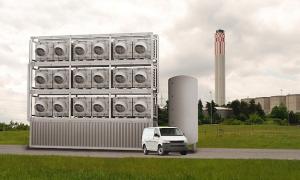LAB REPORT
Science and Technology Making Headlines
Feb. 13, 2015


Lawrence Livermore Engineer Sat Pannu and his Neural Tech Group research team are developing wireless electronic packages that would contain electronics that record and stimulate the peripheral nervous system to control movement and sensation in a patient’s prosthetic hand. Photo by Julie Russell/LLNL
A touching feeling
Lawrence Livermore has been tapped to join a collaborative research team that intends to build the world’s first neural system to enable naturalistic feeling and movements in prosthetic hands.
Known as Hand Proprioception and Touch Interfaces (HAPTIX), the program seeks to provide wounded service members with dexterous control over advanced prosthetic devices that substitute for amputated hands. If successful, HAPTIX intends to give patients the psychological benefit of having natural sensation in their prosthetic hands and reduction of “phantom limb” pain, a sensation some amputees can feel despite the removal of a limb.
Lawrence Livermore’s Neural Tech Group and their collaborators (Case Western Reserve University and the Louis Stokes Cleveland Veterans Administration Medical Center) intend to develop neural interface systems that measure and decode motor signals recorded in peripheral nerves and muscles in the forearm by using tiny electrodes.


Lab researchers Will Smith and John Vericella look at microcapsules that can be used to capture carbon dioxide from coal or natural gas-fired power plants. Photo by Julie Russell/LLNL
Small capsules have big impact on carbon capture
A team of Lawrence Livermore scientists have made a significant advance capturing carbon dioxide with a little bit of help from one of the main ingredients in baking soda.
They developed microcapsules — made up of a highly permeable polymer shell and a fluid composed of sodium carbonate solution — that can safely suck out carbon dioxide from coal or natural gas-fired power plants.
The method involving the first demo of its kind for controlled CO2 capture and release also can be used in industrial processes such as steel and cement production.


LLNL physical chemist George Farquar, who led a Lab team that invented DNATrax, demonstrates how the product can be applied to food to identify it down the food chain. If the food turns out to be tainted, DNATrax can trace it back to the source. Photos by Julie Russell/LLNL
Traces of food contamination
According to the Centers for Disease Control and prevention, 1 in 6 Americans are sickened by foodborne illnesses. However, most contaminated foods are never traced back to their source because existing methods to track tainted food following its supply chain from table to farm are highly inefficient.
But Lawrence Livermore researchers, in collaboration with the startup DNATrek, have developed a cost-effective and highly efficient method to accurately trace contaminated food back to its source. Think of it as a microscopic barcode that’s sprayed on food at the farm or processing plant.
DNATrax are particles comprised of sugar and non-living and non-viable DNA that can serve as an invisible barcode. It’s an odorless and tasteless substance that’s been approved by the Food and Drug Administration as a food additive, safe for consumption.

New laser-driven shock compression experiments on stishovite, a high-density form of silica, provide thermodynamic and electrical conductivity data at unprecedented conditions and reveal the unusual properties of rocks deep inside large exoplanets. Photo by E. Kowaluk, LLE
Super-Earths are a blast
Using laser blasts, Lawrence Livermore scientists have recreated the extreme temperatures and pressures found inside large rocky planets known as super-Earths as well as in icy giant planets such as Neptune and Uranus, shedding light on what the interiors of these exotic worlds are like.
The new findings suggest that the interiors of super-Earth exoplanets may consist of oceans of molten rock that generate magnetic fields, and that giant planets may contain solid, rocky cores, researchers say.
In the past 20 years or so, astronomers have confirmed the existence of more than 1,800 planets orbiting distant stars. The planets include types different from those seen in our own solar system — such as super-Earths, which are rocky planets up to 10 times as massive as Earth.


Lab researcher Suzanne Singer supports energy security through projects in energy efficiency and renewable energy. Photos by Julie Russell/LLNL.
She’s an inspiration
Suzanne Singer, an energy and thermal fluids analyst at Lawrence Livermore is the latest profile in the Energy Department’s #WomenInSTEM video series.
Singer works in solar forecasting, where she tries to predict how much solar energy a solar farm will produce.
She also works to build collaborations between the Energy Department’s National Labs and Native American tribes across the country





